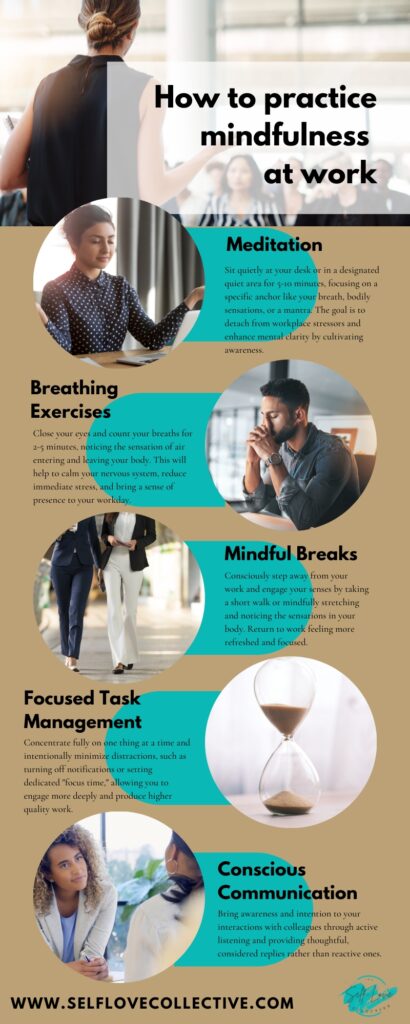
How to Practice Mindfulness at Work
Practicing mindfulness at work can significantly reduce stress and burnout. It also boosts focus and concentration, increasing productivity and better decision-making.
Beyond individual benefits, mindfulness can foster improved emotional regulation, stronger workplace relationships, and enhanced overall job satisfaction.
Even a few moments of mindful practice can make a big difference to your day!
Here are a few ideas to practice daily.
Short Meditation
In a study conducted by the Chicago School of Professional Psychology, participants reported significantly decreased stress levels after a week of five-minute mindfulness meditation exercises.
Dedicate 5-10 minutes daily to a formal meditation practice, guided or unguided. You might sit quietly at your desk or in a designated quiet area in your home or office. Focus on a specific anchor like your breath, bodily sensations, or a mantra. The goal is to cultivate awareness, calm the mind, and improve focus, helping to detach from workplace stressors and enhance mental clarity.
To build this habit, block off time on your calendar daily to ensure consistent, uninterrupted practice.
Check out this 10-minute unguided meditation with soothing music to center your energy.
Breathing Exercises
Take a few moments at your desk or in a quiet space to focus on your breath intentionally. Common breathwork exercises include:
- Diaphragmatic (belly) breathing
- Box breathing (inhaling, holding, exhaling, holding for equal counts)
- Slowing down your inhales and exhales
These exercises quickly activate the body’s relaxation response, calm the nervous system, reduce immediate stress, and bring a sense of presence to your workday. This 6-minute guided breathing meditation is a great place to start.
Mindful Breaks
Stop the scroll! Take a mindful break to engage your senses and recharge consciously.
Try taking a short walk, paying attention to the feeling of your feet on the ground.
I prefer to take a mindful stretch while noticing the sensations in my body.
Another great option is to look away from your screen to observe something in your environment…without judgment. You don’t want to divert your attention by engaging new thoughts. You simply want to disengage from the task at hand.
These short breaks help prevent mental fatigue and allow you to return to tasks with renewed focus.

Focused Task Management
Focusing on a single task can be challenging. How many tabs do you currently have open in your browser? Yeah, same here!
Needless to say, “multitasking” can decrease efficiency and increase stress.
Turn off notifications or set dedicated “focus time” to engage more deeply and produce higher-quality work.
Eliminating these distractions means you can dedicate your mental resources to the current activity until it’s complete or to a planned stopping point. This improves concentration, reduces errors, and can make work feel less overwhelming and more productive.
Conscious Communication
Practicing conscious communication can lead to clearer understanding, fewer misunderstandings, stronger professional relationships, and a more positive work environment. Bring awareness and intention to your interactions with colleagues by:
- Engaging in workplace interactions with full awareness and intention
- Listening to understand others (active listening), rather than just waiting for your turn to speak, and responding thoughtfully and clearly.
How do you practice mindfulness at work? Please leave your ideas in the comments.




